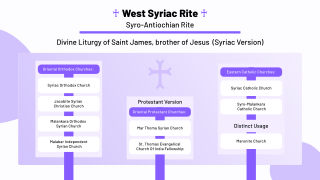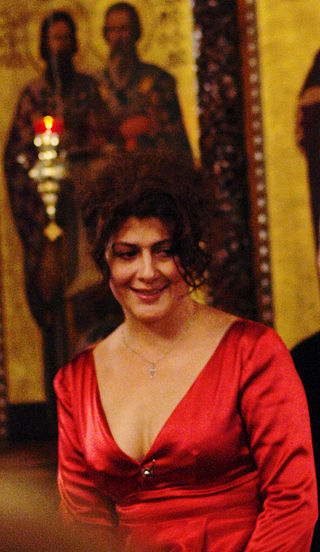
The Liturgy of Saint James is a form of Christian liturgy used by some Eastern Christians of the Byzantine rite and West Syriac Rite. It is developed from an ancient Egyptian form of the Basilean anaphoric family, and is influenced by the traditions of the rite of the Church of Jerusalem, as the Mystagogic Catecheses of Cyril of Jerusalem imply. It became widespread in Church of Antioch from the fourth or fifth century onwards, replacing the older Basilean Liturgy of Antioch. It is still the principal liturgy of the Syriac Orthodox Church, the Malankara Orthodox Syrian Church, the Maronite Church, the Syriac Catholic Church, Syro-Malankara Catholic Church and other churches employing the West Syriac Rite. It is also occasionally used in the Eastern Orthodox Church and Melkite Catholic Church. The Malankara Mar Thoma Syrian Church uses a reformed variant of this liturgy, omitting intercession of saints and prayer for the dead.
Christian liturgy is a pattern for worship used by a Christian congregation or denomination on a regular basis. The term liturgy comes from Greek and means "public work". Within Christianity, liturgies descending from the same region, denomination, or culture are described as ritual families.

The Anaphora is the most solemn part of the Eucharistic liturgies, such as the Divine Liturgy or the Mass, which serves as a thanksgiving prayer by virtue of which the offerings of bread and wine are consecrated as the body and blood of Christ. This is the usual name for this part of the Liturgy in Greek-speaking Eastern Christianity. In the Eastern Syriac tradition Qudaša is its equivalent. The corresponding part in western Christian liturgy is nowadays most often called the Eucharistic Prayer. The Roman Rite from the 4th century until after Vatican II had a single such prayer, called the Canon of the Mass.
Liturgy of St John Chrysostom, Op. 31, is a 1910 musical work by Sergei Rachmaninoff, one of his two major unaccompanied choral works. The Divine Liturgy of St. John Chrysostom is the primary worship service of the Eastern Orthodox Church.
DivineLiturgy of Saint John Chrysostom or Liturgy of Saint John Chrysostom may refer to:

The West Syriac Rite, also called the Syro-Antiochian Rite and the West Syrian Rite, is an Eastern Christian liturgical rite that employs the Divine Liturgy of Saint James in the West Syriac dialect. It is practised in the Maronite Church, the Syriac Orthodox Church, the Syriac Catholic Church and various Malankara Churches of India. It is one of two main liturgical rites of Syriac Christianity, the other being the East Syriac Rite. It originated in the ancient Patriarchate of Antioch. It has more anaphoras than any other rite.

Antiochene Rite also known as Antiochian Rite refers to the family of liturgies originally used by the patriarch of Antioch.

The Alexandrian rites are a collection of ritual families and uses of Christian liturgy employed by three Oriental Orthodox churches, and by three Eastern Catholic Churches.
The Liturgy of Saint Basil or, more formally, the Divine Liturgy of Saint Basil the Great, is a term for several Eastern Christian celebrations of the Divine Liturgy (Eucharist), or at least several anaphoras, which are named after Basil of Caesarea. Two of these liturgies are in common use today: the one used in the Byzantine Rite ten times a year, and the one ordinarily used by the Coptic Church.

Eastern Lutheranism refers to Lutheran churches, such as those of Ukraine and Slovenia, that use a form of the Byzantine Rite as their liturgy. It is unique in that it is based on the Eastern Christian rite used by the Eastern Orthodox Church, while incorporating theology from the Divine Service contained in the Formula Missae, the base texts for Lutheran liturgics in the West.
The Liturgy of St. John Chrysostom is an a cappella choral composition by Pyotr Ilyich Tchaikovsky, his Op. 41, composed in 1878. It consists of settings of texts taken from the Divine Liturgy of St. John Chrysostom, the most celebrated of the eucharistic services of the Eastern Orthodox Church. Tchaikovsky's setting constitutes the first "unified musical cycle" of the liturgy.
Only-Begotten Son, sometimes called "Justinian's Hymn", the "Anthem of Orthodoxy" and/or the "Hymn of the Incarnation", is an ancient Christian hymn that was composed prior to the middle of the 6th century. It is chanted at the end of the Second Antiphon during the Divine Liturgies of St John Chrysostom, St Basil the Great and of St Gregory the Illuminator, and at the Little Entrance during the Liturgy of Saint James.
The Divine Liturgy of St. John Chrysostom is a work by the prominent Serbian composer Stevan Stojanović Mokranjac (1856–1914), composed in 1895. It is one of the most famous and most popular compositions of the Divine Liturgy in Serbian art and is officially recognized as part of the service in the Serbian Orthodox Church.

Anamnesis is a liturgical statement in Christianity in which the Church refers to the memorial character of the Eucharist or to the Passion, Resurrection and Ascension of Jesus. It has its origin in Jesus' words at the Last Supper, "Do this in memory of me" ("τοῦτο ποιεῖτε εἰς τὴν ἐμὴν ἀνάμνησιν",.

The Coptic Rite is an Alexandrian liturgical rite. It is practised in the Coptic Orthodox Church and the Coptic Catholic Church.

The Liturgy of Saint Cyril is one of the three Anaphoras used at present by the Coptic Catholic Church and the Coptic Orthodox Church and it retains the liturgical peculiarities which have originated in the early Christian Egypt, thus forming the core of the historical Alexandrian Rite. When reference is made to its Greek Byzantine Rite version, this text is usually known as Liturgy of Saint Mark.
The Liturgy of St. John Chrysostom is the musical setting of the Divine Liturgy of St. John Chrysostom by Mykola Leontovych. Consistent with Orthodox tradition, in which service is sung exclusively a cappella, the piece is set for unaccompanied choir and soloist. It was first performed in the Mykolaiv Cathedral at the Kyiv Pechersk Lavra on May 22, 1919, with Leontovych himself conducting.

Divna Ljubojević, sometimes called by just her first name, Divna, is a Serbian singer and conductor of Orthodox Christian sacred music in various languages. She is the conductor and artistic director of the Melodi ensemble, a "choir and studio for spiritual music". which she founded with a group of her friends.

The Holy Qurobo or Holy Qurbono refers to the Eucharist as celebrated in Syro-Antiochene Rite and the liturgical books containing rubrics for its celebration. West Syriac Rite includes various descendants of the Oriental Orthodox and Eastern Catholic churches. It consists of two distinct liturgical traditions: the Maronite Rite, and the Jacobite Rite. The major Anaphora of both the traditions is the Divine Liturgy of Saint James in Syriac language. The Churches are primarily based in the Middle East, Africa, and India.
The Eastern Catholic Churches of the Catholic Church utilize liturgies originating in Eastern Christianity, distinguishing them from the majority of Catholic liturgies which are celebrated according to the Latin liturgical rites of the Latin Church. While some of these sui iuris churches use the same liturgical ritual families as other Eastern Catholic churches and Eastern churches not in full communion with Rome, each church retains the right to institute its own canonical norms, liturgical books, and practices for the ritual celebration of the Eucharist, other sacraments, and canonical hours.






